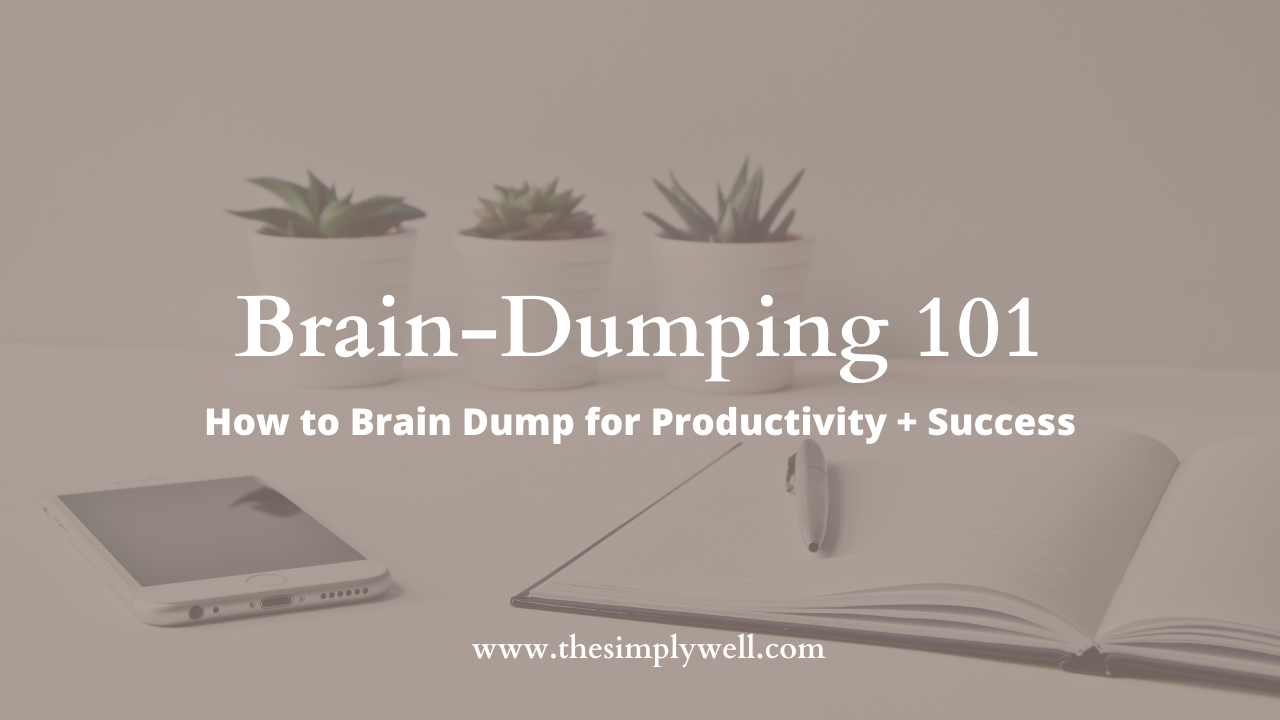
How to Brain Dump to Increase Productivity, Clarity, and Calm
Jul 07, 2020Have you ever had about 100 internet browsers open, only to realize that your computer is overheating, taking about ten times longer than usual to load, and making a concerning fanning sound?!!
I’m guessing that you probably have.
Now, have you ever had that same feeling in your brain?? You know, when you have dozens of different thoughts running through your mind simultaneously and can’t concentrate on any single task?
Yeah, me too.
Sometimes, my brain is so full that I can’t zero in on any one thought without ten other desperate ideas zooming through. When I feel overwhelmed, my brain manages to jump from the task at hand, to tomorrow’s to-do list, to an errand I have to run, to all the cabinets I need to organize, to that thing I promised a friend I’d do, all in the span of about 30 seconds. And just like an overloaded laptop, all these open mental “tabs” eventually cause me to shut down.
If you too are familiar with this feeling, you may be searching for an easy and effective way to clear out mental clutter so that you can actually focus on the things that matter.
Enter the brain dump.
Though possessive of, in my opinion, a wildly unattractive name, the brain dump itself is an invaluable process for organizing your thoughts and quieting incessant mental chatter.
Popularized in David Allen’s 2002 book Getting Things Done, brain dumping is all about being intentional about what information you store your brain, and what gets stored elsewhere. In other words, brain dumping is a tool you can use to transform an overcommitted, overwhelmed, and disorganized mind into one that is calm and focused.
After trying a handful of different brain dump approaches, I’ve developed my own spin on what I find to be most useful.
Let’s explore the process.
Step 1. Writing it all down
For the first part of the brain dump process, you’ll need a piece of paper and something to write with. Set aside some time to write, likely around 15-20 minutes (though the time may vary depending on your current level of brain overload). If you think it’d be helpful, you can always set a timer.
Sit down and write a list of everything you can think of that has been occupying space in your mind.
Your list may consist of tasks to do, errands to run, or events to attend. It may include recent conversations you have had, decisions you need to make, or unresolved situations that have been on your mind. Your list may include a mix of home, work, personal, or friend-related items. Big projects, little projects, and all the projects in between.
At this point, there is no need to edit, filter, or organize your list. Also, keep in mind that what you write down doesn’t need to make sense to anyone else.
Here are some examples of items you may write down:
-
Call plumber
-
Fill out school permission slips
-
Buy cake mix
-
Order towels
-
Read article Julie sent
-
Submit timesheets
-
Organize pantry
-
Convo with Bill
-
Fix take-out menu drawer
-
Finish editing photos
-
Talk to Emily about job offer
Step 2. Prompts
After you’ve written down everything that comes to mind, consider the following prompts and add anything else you think of to the list:
-
House related tasks (cleaning, fixing, organizing)
-
Health and fitness (pick up prescription, go to the doctor, research fitness programs)
-
Books, articles, education, personal development
-
Emails to write
-
Bills to pay
-
Family
-
Friends/colleagues
Step 3. Take a Break
At this point, taking a break may seem superfluous, and with all the pressure you’re feeling to organize your thinking and be productive, it is tempting to skip.
But trust me, after doing your initial brain dump, you’ll need to take. a. break.
Even a 15 minute pause can mean the difference between an effective brain dump and one that is just, well, eh. Also, keep in mind that taking a little time away can allow you to return to your list with a fresh and more grounded perspective.
So go for a walk around the block. Get a snack. Switch the laundry. And come back to your list at least 15 minutes later. Your brain dump process will be much better for it.
Step 4. Categorizing Your List
Now comes the fun part! Go through your list one item at a time and decide what to do about each item.
I recommend starting a “task management” page while you do this, either in the form of your regular planner, a to-do list, or even an Eisenhower Decision Matrix.
Turn each item on your brain dump list into either a “to-do” or a “to-let-go-of.”
Some items on your list will be straightforward. For example, you can easily add simple items such as “call plumber,” “organize pantry,” or “order towels” to your planner. The key is to actually assign these tasks to specific days so that you no longer have to store them in your mind. Say hello to increased feelings of clarity and mental freedom!
Other items may be a little trickier. For example, if some of the things you wrote down are more nebulous, such as a tough conversation you keep putting off, a job offer you need to accept or decline, or a recent embarrassment that keeps spinning through your mind, it may not be so easy to figure out exactly what to do.
Nonetheless, do your best to either turn these items into actionable steps or decide to let them go.
Let me give you some examples. You could turn an item such as “Need to have tough conversation with Jerry” into “Write a list of 3 key points I want to address with Jerry” and then add it to a specific day on your calendar. Similarly, an item such as “Decide whether to accept teaching position” could be turned into “Write a list of pros and cons of accepting teaching position” or “Call Sal for advice about accepting job offer.”
Furthermore, you can turn something like a recent embarrassing situation spinning through your mind into one of the following action items: a) an apology you need to make, b) a call to a friend to debrief and get some perspective on the situation, c) a journaling session to explore your emotions regarding the event, or d) a decision to simply let it go.
So, do you see what I mean?
Pretty much everything you wrote down can be turned into a “to-do” or a “to-let-go-of.” And storing and scheduling these ideas somewhere other than your brain opens up space for immense mental clarity.
And that’s it! It’s as easy as 1, 2, 3… 4!
Keep in mind, humans have a limited amount of mental real estate, and there is no sense in bogging down your brain with things that can be written down, scheduled, and released. If you’re suffering from chronic brain overload, I recommend doing a brain dump at least once a month to keep yourself feeling clear and motivated.





